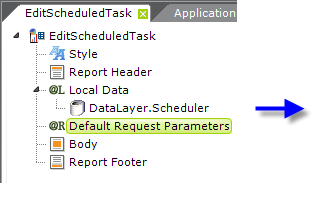Working with Process Parameters
Parameters, in the format of name-value pairs, can be stored with a Scheduler task and passed to the target Process task when the Scheduler task runs. The Schedule element includes an user input control set that it displays for entering and editing these parameters. Its appearance in the UI is controlled by the element's Show Process Parameters attribute.

As shown above, the Schedule element's interface can be used to add a number of parameters at runtime. As the parameters are entered, they're assembled into an XML string and placed into a hidden input control with the ID rdProcessParams_<Schedule Element ID>.
Saving the Parameters
When a Process task is called to save the task data, the XML string of parameters is passed to it as a request variable. The elements used to store Scheduler data, Procedure.Scheduler Create Task and Procedure.Scheduler Update Task, will automatically look for and use this request variable and store the parameters with the Scheduler task.
Retrieving the Parameters
We need to reverse the previous process to retrieve the stored parameters and load them into the Schedule element:


The example shown above is of a definition that will allow users to edit stored Scheduler tasks. A DataLayer.Scheduler, a child of Local Data, is used to retrieve data for the desired Scheduler task. Then a Default Request Parameters element is used with a Local token to create a request variable named rdProcessParams_<Schedule Element ID> with the value of the ProcessParams column in the datalayer. This will automatically load any stored parameters into the Schedule element interface, so that they can be edited.